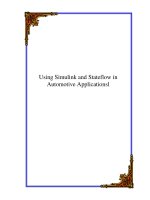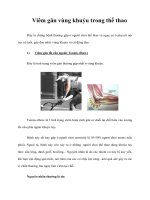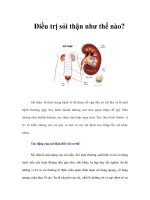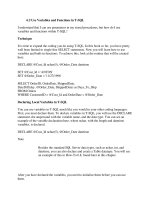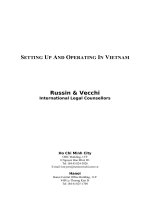Tài liệu RESPIRATORY CONTROL AND DISORDERS IN THE NEWBORN doc
Bạn đang xem bản rút gọn của tài liệu. Xem và tải ngay bản đầy đủ của tài liệu tại đây (3.93 MB, 631 trang )
RESPIRATORY
CONTROL
AND
DISORDERS
IN THE
NEWBORN
Edited
by
Oommen
P.
Mathew
Brody
School
of
Medicine
at
East Carolina University
Greenville,
North Carolina, U.S.A.
MARCEL
MARCEL DEKKER,
INC.
NEW
YORK
•
BASEL
m
DEKKER
ISBN: 0-8247-0984-5
This book is printed on acid-free paper.
Headquarters
Marcel Dekker, Inc.
270 Madison Avenue, New York, NY 10016
tel: 212-696-9000; fax: 212-685-4540
Eastern Hemisphere Distribution
Marcel Dekker AG
Hutgasse 4, Postfach 812, CH-4001 Basel, Switzerland
tel: 41-61-260-6300; fax: 41-61-260-6333
World Wide Web
http:== www.dekker.com
The publisher offers discounts on this book when ordered in bulk quantities. For more infor-
mation, write to Special Sales=Professional Marketing at the headquarters address above.
Copyright # 2003 by Marcel Dekker, Inc. All Rights Reserved.
Neither this book nor any part may be reproduced or transmitted in any form or by any
means, electronic or mechanical, including photocopying, microfilming, and recording, or
by any information storage and retrieval system, without permission in writing from the
publisher.
Current printing (last digit):
10987654321
PRINTED IN THE UNITED STATES OF AMERICA
LUNG BIOLOGY
IN
HEALTH
AND
DISEASE
Executive
Editor
Claude
Lenfant
Director
National Heart Lung
and
Blood Institute
National
Institutes
of
Health
Bethesda
Maryland
1
Immunologic
and
Infectious Reactions
in
the
Lung, edited
by C H
Kirkpatnck
and H Y
Reynolds
2
The
Biochemical Basis
of
Pulmonary Function, edited
by R G
Crystal
3
Bioengmeering
Aspects
of
the
Lung, edited
by J
B
West
4
Metabolic Functions
of the
Lung, edited
byYS
Bakhle
and J R
Vane
5
Respiratory Defense Mechanisms
(in
two
parts), edited
by J D
Brain,
D F
Proctor,
and L
M
Reid
6
Development
of the
Lung, edited
byWA
Hodson
7
Lung Water
and
Solute Exchange, edited
by N C
Staub
8
Extrapulmonary
Manifestations
of
Respiratory Disease, edited
by E D
Robin
9
Chronic Obstructive Pulmonary Disease, edited
byTL
Petty
10
Pathogenesis
and
Therapy
of
Lung Cancer, edited
by C C
Harris
11
Genetic Determinants
of
Pulmonary Disease, edited
by S D
Litwin
12
The
Lung
in
the
Transition
Between Health
and
Disease,
ecMed
by P T
Macklem
and S
Permutt
13
Evolution
of
Respiratory
Processes
A
Comparative Approach, edited
by
S C
Wood
and
C
Lenfant
14
Pulmonary
Vascular Diseases, edited
by K M
Moser
15
Physiology
and
Pharmacology
of the
Airways, edited
byJA
Nadel
16
Diagnostic Techniques
in
Pulmonary Disease
(in
two
parts), edited
by
M A
Sackner
17
Regulation
of
Breathing
(in
two
parts), edited
byTF
Hombem
18
Occupational Lung Diseases Research Approaches
and
Methods,
edited
by H
Weill
and M
Turner-Warwick
19
Immunopharmacology
of
the
Lung, edited
by H H
Newball
20
Sarcoidosis
and
Other Granulomatous Diseases
of the
Lung,
edited
by
B L
Fanburg
21
Sleep
and
Breathing, edited
by N A
Saunders
and C E
Sullivan
22
Pneumocystis
cannii
Pneumonia Pathogenesis, Diagnosis,
and
Treat-
ment, edited
by L S
Young
23
Pulmonary Nuclear Medicine Techniques
in
Diagnosis
of
Lung
Dis-
ease,
edited
by H L
Atkins
24
Acute Respiratory Failure, edited
byWM
Zapol
and K J
Falke
25
Gas
Mixing
and
Distribution
in
the
Lung, edited
by L A
Engel
and M
Paiva
26.
High-Frequency
Ventilation
in
Intensive Care
and
During Surgery,
edited
by G.
Carton
and W. S.
Howland
27.
Pulmonary Development: Transition from Intrauterine
to
Extrauterine
Life, edited
by G. H.
Nelson
28.
Chronic Obstructive Pulmonary Disease: Second Edition, edited
by T. L.
Petty
29. The
Thorax
(in two
parts), edited
by C,
Roussos
and P. T.
Macklem
30. The
Pleura
in
Health
and
Disease, edited
by J.
Chretien,
J.
Bignon,
and
A.
Hirsch
31.
Drug Therapy
for
Asthma: Research
and
Clinical Practice, edited
by J.
W.
Jenne
and S.
Murphy
32.
Pulmonary
Endothelium
in
Health
and
Disease, edited
by
U.
S.
Ryan
33.
The
Airways: Neural Control
in
Health
and
Disease, edited
by M. A.
Kaliner
and P. J.
Barnes
34.
Pathophysiology
and
Treatment
of
Inhalation Injuries, edited
by J.
Loke
35.
Respiratory Function
of the
Upper Airway, edited
by O. P.
Mathew
and
G.
Sant'Ambrogio
36.
Chronic
Obstructive
Pulmonary
Disease:
A
Behavioral
Perspective,
edited
by A. J.
McSweeny
and I.
Grant
37.
Biology
of
Lung Cancer: Diagnosis
and
Treatment, edited
by S. T.
Rosen,
J. L.
Mulshine,
F.
Cuttitta,
and P. G.
Abrams
38.
Pulmonary Vascular Physiology
and
Pathophysiology, edited
by E. K.
Weir
and J. T.
Reeves
39.
Comparative Pulmonary Physiology: Current Concepts, edited
by S. C.
Wood
40.
Respiratory Physiology:
An
Analytical Approach, edited
by H. K.
Chang
and M.
Paiva
41.
Lung Cell Biology, edited
by D.
Massaro
42.
Heart-Lung
Interactions
in
Health
and
Disease,
edited
by S. M.
Scharf
and
S. S.
Cassidy
43.
Clinical Epidemiology
of
Chronic Obstructive Pulmonary Disease, edited
by
M. J.
Hensley
and N. A.
Saunders
44.
Surgical Pathology
of
Lung Neoplasms, edited
by A. M.
Marchevsky
45. The
Lung
in
Rheumatic
Diseases,
edited
by G. W.
Cannon
and G. A.
Zimmerman
46.
Diagnostic Imaging
of the
Lung, edited
by C. E.
Putman
47.
Models
of
Lung Disease: Microscopy
and
Structural Methods, edited
by
J. Gil
48.
Electron Microscopy
of the
Lung, edited
by D. E.
Schraufnagel
49.
Asthma:
Its
Pathology
and
Treatment, edited
by M. A.
Kaliner,
P. J.
Barnes,
and C. G. A.
Persson
50.
Acute Respiratory Failure: Second Edition, edited
by W. M.
Zapol
and
F.
Lemaire
51.
Lung Disease
in the
Tropics, edited
by O. P.
Sharma
52.
Exercise: Pulmonary Physiology
and
Pathophysiology, edited
by B. J.
Whipp
and K.
Wasserman
53.
Developmental Neurobiology
of
Breathing, edited
by G. G.
Haddad
and
J.
P.
Farber
54.
Mediators
of
Pulmonary Inflammation, edited
by M. A.
Bray
and W. H.
Anderson
55. The
Airway Epithelium, edited
by S. G.
Farmer
and D. Hay
56
Physiological Adaptations
in
Vertebrates Respiration, Circulation,
and
Metabolism,
edited
by S C
Wood
R E
Weber,
A R
Hargens,
and R
W
Millard
57 The
Bronchial Circulation, edited
by
J
Butler
58
Lung Cancer Differentiation
Implications
for
Diagnosis
and
Treatment,
edited
by
S D
Bernal
and P J
Hesketh
59
Pulmonary Complications
of
Systemic Disease, edited
by J F
Murray
60
Lung
Vascular Injury Molecular
and
Cellular
Response, edited
by A
Johnson
and T J
Ferro
61
Cytokmes
of the
Lung, edited
by J
Kelley
62
The
Mast Cell
in
Health
and
Disease, edited
by M A
Kalmerand
D D
Metcalfe
63
Pulmonary Disease
in
the
Elderly Patient, edited
by D A
Mahler
64
Cystic
Fibrosis,
edited
by P B
Davis
65
Signal
Transduction
in
Lung Cells, edited
by J S
Brody,
D M
Center,
and V A
Tkachuk
66
Tuberculosis
A
Comprehensive International Approach, edited
by L B
Reichman
and E S
Hershfield
67
Pharmacology
of the
Respiratory Tract Experimental
and
Clinical
Re-
search, edited
by
K
F
Chung
and P J
Barnes
68
Prevention
of
Respiratory Diseases, edited
by A
Hirsch,
M
Goldberg,
J -P
Martin,
and R
Masse
69
Pneumocystis
cannn
Pneumonia Second
Edition,
edited
by P D
Walzer
70
Fluid
and
Solute Transport
in
the
Airspaces
of the
Lungs, edited
by R
M
EffrosandH
K
Chang
71
Sleep
and
Breathing Second Edition, edited
by N A
Saunders
and C
E
Sullivan
72
Airway Secretion Physiological Bases
for the
Control
of
Mucous
Hy-
persecretion,
edited
by T
Takishima
and S
Shtmura
73
Sarcoidosis
and
Other Granulomatous Disorders, edited
by D G
James
74
Epidemiology
of
Lung Cancer, edited
by J M
Samet
75
Pulmonary Embolism, edited
by M
Morpurgo
76
Sports
and
Exercise Medicine, edited
bySC
Wood
and R C
Roach
77
Endotoxm
and the
Lungs, edited
by K L
Bngham
78 The
Mesothehal
Cell
and
Mesothehoma,
edited
by M -C
Jaurand
and J
Bignon
79
Regulation
of
Breathing Second Edition, edited
by J A
Dempsey
and
A
I
Pack
80
Pulmonary Fibrosis, edited
by S
Hm
Phan
and R S
Thrall
81
Long-Term
Oxygen Therapy
Scientific
Basis
and
Clinical
Application,
edited
by W J
O'Donohue,
Jr
82
Ventral
Bramstem
Mechanisms
and
Control
of
Respiration
and
Blood
Pressure, edited
by C
O
Trouth,
R M
Millts,
H F
Kiwull-Schone,
and
M E
Schlafke
83
A
History
of
Breathing Physiology, edited
by D F
Proctor
84
Surfactant Therapy
for
Lung Disease, edited
by B
Robertson
and H W
Taeusch
85
The
Thorax Second Edition, Revised
and
Expanded
(in
three parts),
edited
by
C
Roussos
86.
Severe Asthma: Pathogenesis
and
Clinical
Management,
edited
by S. J.
Szefler
and D. Y. M.
Leung
87.
Mycobacterium
avw/n-Complex
Infection: Progress
in
Research
and
Treatment,
edited
by J. A.
Korvick
and C. A.
Benson
88.
Alpha
1-Antitrypsin
Deficiency: Biology
•
Pathogenesis
•
Clinical Mani-
festations
•
Therapy,
edited
by R. G.
Crystal
89.
Adhesion Molecules
and the
Lung, edited
by P. A.
Ward
and J. C.
Fantone
90.
Respiratory Sensation,
edited
by
L
Adams
and A. Guz
91.
Pulmonary Rehabilitation, edited
by A. P.
Fishman
92.
Acute Respiratory Failure
in
Chronic Obstructive Pulmonary Disease,
edited
by
J P.
Derenne,
W. A.
Whitetaw,
and T.
Similowski
93.
Environmental Impact
on the
Airways: From Injury
to
Repair,
edited
by
J.
Chretien
and D.
Dusser
94.
Inhalation Aerosols: Physical
and
Biological Basis
for
Therapy,
edited
by A. J.
Mickey
95.
Tissue
Oxygen
Deprivation:
From
Molecular
to
Integrated
Function,
edited
by G. G.
Haddad
and G.
Lister
96. The
Genetics
of
Asthma,
edited
by S.
B.
Liggett
and D. A.
Meyers
97.
Inhaled
Glucocorticoids
in
Asthma: Mechanisms
and
Clinical Actions,
edited
by R. P.
Schleimer,
W. W.
Busse,
and P. M.
O'Byrne
98.
Nitric Oxide
and the
Lung,
edited
by W. M.
Zapol
and K. D.
Bloch
99.
Primary Pulmonary Hypertension,
edited
by L. J.
Rubin
and S.
Rich
100.
Lung Growth
and
Development,
edited
by J. A.
McDonald
101. Parasitic Lung Diseases,
edited
by A. A. F.
Mahmoud
102.
Lung
Macrophages
and
Dendritic Cells
in
Health
and
Disease,
edited
by
M. F.
Lipscomb
and S. W.
Russell
103.
Pulmonary
and
Cardiac Imaging, edited
by C.
Chiles
and C. E.
Putman
104.
Gene Therapy
for
Diseases
of the
Lung,
edited
by K. L.
Brigham
105.
Oxygen, Gene Expression,
and
Cellular Function,
edited
by L.
Biadasz
Clerch
and D. J.
Massaro
106.
Beta
2
-Agonists
in
Asthma Treatment, edited
by R.
Pauwels
and P. M.
O'Byme
107.
Inhalation Delivery
of
Therapeutic Peptides
and
Proteins,
edited
by A. L.
Adjei
and P. K.
Gupta
108.
Asthma
in the
Elderly,
edited
by R. A.
Barbee
and J. W.
Bloom
109. Treatment
of the
Hospitalized Cystic Fibrosis Patient,
edited
by D. M.
Orenstein
and R. C.
Stern
110.
Asthma
and
Immunological
Diseases
in
Pregnancy
and
Early Infancy,
edited
by M.
Schatz,
R. S.
Zeiger,
and H. N.
Claman
111.
Dyspnea,
edited
by D. A.
Mahler
112.
Proinflammatory
and
Antiinflammatory
Peptides,
edited
by S. I.
Said
113.
Self-Management
of
Asthma,
edited
by H.
Kotses
and A.
Harver
114. Eicosanoids, Aspirin,
and
Asthma,
edited
by A.
Szczeklik,
R. J.
Gryglewski,
and J. R.
Vane
115.
Fatal Asthma,
edited
by
A. L
Sheffer
116.
Pulmonary Edema,
edited
by M. A.
Matihay
and D. H.
Ingbar
117.
Inflammatory Mechanisms
in
Asthma,
edited
by S. T.
Holgate
and W.
W.
Busse
118.
Physiological Basis
of
Ventilatory
Support,
edited
by J. J.
Marini
and A.
S.
Slutsky
119
Human Immunodeficiency Virus
and the
Lung, edited
by M J
Rosen
and
J M
Beck
120
Five-Lipoxygenase
Products
in
Asthma, edited
by J M
Drazen,
S-E
Dahlen,
and T H Lee
121
Complexity
in
Structure
and
Function
of the
Lung, edited
by M P
Hlastala
and H T
Robertson
122
Biology
of
Lung Cancer, edited
by M A
Kane
and P A
Bunn,
Jr
123
Rhinitis Mechanisms
and
Management, edited
by R M
Nacleno,
S R
Durham,
and N
Mygind
124
Lung Tumors Fundamental Biology
and
Clinical Management, edited
by
C
Brambilla
and £
Brambilla
125
lnterleukm-5
From Molecule
to
Drug Target
for
Asthma, edited
by C J
Sanderson
126
Pediatnc
Asthma edited
by S
Murphy
and H
W
Kelly
127
Viral Infections
of the
Respiratory Tract, edited
by R
Dolin
and P F
Wright
128
Air
Pollutants
and the
Respiratory Tract, edited
by D L
Swift
and W M
Foster
129
Gastroesophageal Reflux Disease
and
Airway Disease, edited
by M R
Stem
130
Exercise-Induced Asthma, edited
by E R
McFadden,
Jr
131 LAM and
Other Diseases Characterized
by
Smooth Muscle Prolifera-
tion,
edited
by J
Moss
132 The
Lung
at
Depth, edited
by C E G
Lundgren
and J N
Miller
133
Regulation
of
Sleep
and
Circadian
Rhythms, edited
by F W
Turek
and
P
C Zee
134
Anticholmergic
Agents
in
the
Upper
and
Lower Airways, edited
by S L
Spector
135
Control
of
Breathing
in
Health
and
Disease, edited
by M D
Altose
and
Y
Kawakami
136
Immunotherapy
in
Asthma, edited
by
J
BousquetandH
Yssel
137
Chronic Lung Disease
in
Early Infancy, edited
by R D
Bland
and J J
Coalson
138
Asthma's Impact
on
Society
The
Social
and
Economic
Burden,
edited
byKB
Weiss,
A S
Buist,
and S D
Sullivan
139 New and
Exploratory Therapeutic Agents
for
Asthma, edited
by M
Yeadon
and
Z
Diamant
140
Multimodality
Treatment
of
Lung Cancer, edited
by
A T
Skann
141
Cytokmes
in
Pulmonary Disease Infection
and
Inflammation, edited
by
S
Nelson
and T R
Martin
142. Diagnostic Pulmonary Pathology, edited
by P T
Cagle
143
Particle-Lung
Interactions, edited
by P
GehrandJ
Heyder
144
Tuberculosis
A
Comprehensive International Approach, Second Edi-
tion,
Revised
and
Expanded, edited
by L B
Reichman
and E S
Hershfietd
145
Combination Therapy
for
Asthma
and
Chronic Obstructive Pulmonary
Disease, edited
by R J
Martin
and M
Kraft
146
Sleep Apnea Implications
in
Cardiovascular
and
Cerebrovascular
Di-
sease, edited
by T D
Bradley
and J S
Floras
147
Sleep
and
Breathing
in
Children
A
Developmental Approach, edited
by
G
M
Loughlm,
J L
Carroll,
and C L
Marcus
148.
Pulmonary
and
Peripheral
Gas
Exchange
in
Health
and
Disease, edited
by
J.
Roca,
R.
Rodriguez-Roisen,
and P. D.
Wagner
149. Lung Surfactants: Basic
Science
and
Clinical Applications,
R. H.
A/offer
150.
Nosocomial Pneumonia, edited
by
W.
R,
Jarvis
151.
Fetal Origins
of
Cardiovascular
and
Lung Disease, edited
by
David
J. P.
Barker
152.
Long-Term Mechanical
Ventilation,
edited
by N. S.
Hill
153.
Environmental Asthma, edited
by R. K.
Bush
154.
Asthma
and
Respiratory Infections, edited
by D. P.
Skoner
155. Airway
Remodeling,
edited
by
P.
H.
Howarth,
J. W.
Wilson,
J.
Bous-
quet,
S.
Rak,
and R. A.
Pauwels
156.
Genetic Models
in
Cardiorespiratory
Biology,
edited
by G. G.
Haddad
and T.
Xu
157. Respiratory-Circulatory Interactions
in
Health
and
Disease, edited
by S.
M.
Scharf,
M.
R.
Pinsky,
and S.
Magder
158.
Ventilator Management Strategies
for
Critical Care,
edited
by N. S.
Hill
and M. M.
Levy
159.
Severe Asthma: Pathogenesis
and
Clinical Management, Second
Edition, Revised
and
Expanded,
edited
by S. J.
Szefler
and D. Y. M.
Leung
160.
Gravity
and the
Lung: Lessons from
Microgravity,
edited
by G. K.
Prisk,
M.
Paiva,
and J. B.
West
161. High Altitude:
An
Exploration
of
Human Adaptation, edited
by T. F.
Hornbein
and R. B.
Schoene
162. Drug Delivery
to the
Lung,
edited
by H.
Bisgaard,
C.
O'Caltaghan,
and
G.
C.
Smaldone
163.
Inhaled Steroids
in
Asthma: Optimizing Effects
in the
Airways, edited
by
R.
P.
Schleimer,
P. M.
O'Byme,
S. J.
Szefler,
and R.
Brattsand
164.
IgE
and
Anti-lgE
Therapy
in
Asthma
and
Allergic Disease, edited
by R.
B.
Pick,
Jr.,
and P. M.
Jardieu
165.
Clinical Management
of
Chronic Obstructive Pulmonary Disease,
edited
by T.
Similowski,
W. A.
Whitelaw,
and
J P.
Derenne
166.
Sleep Apnea: Pathogenesis, Diagnosis,
and
Treatment, edited
by A. I.
Pack
167. Biotherapeutic Approaches
to
Asthma,
edited
by J.
Agosti
and A. L.
Sheffer
168.
Proteoglycans
in
Lung Disease,
edited
by H. G.
Garg,
P. J.
Roughley,
and C. A.
Hales
169.
Gene Therapy
in
Lung
Disease,
edited
by S. M.
Albelda
170. Disease Markers
in
Exhaled Breath, edited
by N.
Marczin,
S. A.
Kharito-
nov,
M. H.
Yacoub,
and P. J.
Barnes
171.
Sleep-Related Breathing Disorders: Experimental Models
and
Thera-
peutic
Potential, edited
by D. W.
Cariey
and M.
Radulovacki
172.
Chemokines
in the
Lung, edited
by R. M.
Strieter,
S. L.
Kunkel,
and T.
J.
Standiford
173. Respiratory Control
and
Disorders
in the
Newborn, edited
by O. P.
Mathew
ADDITIONAL VOLUMES
IN
PREPARATION
The
Immunological
Basis
of
Asthma, edited
by
B
N
Lambrecht,
H
C
Hoogsteden,
and Z
Diamant
Therapeutic
Targets
in
Airway
Inflammation,
edited
by N T
Eissa
and
D
Huston
Oxygen Sensing Responses
and
Adaptation
to
Hypoxia,
edited
by S
Lahm,
G
Semenza,
and N
Prabhakar
Non-Neoplastic
Advanced Lung Disease, edited
by J
Maurer
Lung Volume Reduction Surgery
for
Emphysema, edited
by H E
Fesster,
J J
Reilly,
Jr,
and D J
Sugarbaker
Respiratory Infections
in
Asthma
and
Allergy, edited
by S
Johnston
and
N
Papadopoulos
Acute Respiratory
Distress
Syndrome,
edited
by
M
A
Matthay
The
opinions expressed
in
these volumes
do not
necessarily represent
the
views
of
the
National Institutes
of
Health
I want to note with sadness the passing of my former colleague,
Giuseppe Sant’Ambrogio, M.D. He was not only an inspiration to many
but, above all, a friend in the truest sense. His presence in the scientific
community will be sorely missed. I dedicate this book to his memory.
INTRODUCTION
Newborn and infant mortality has been a plague of public health for centuries.
However, during the 1900s, an extraordinary effort began to correct this
disgraceful situation. Especially remarkable have been the accomplishments of
the last 30 years or so. Although many challenges remain, very noticeable
progress has been made relative to some specific causes of death in babies.
In the United States, neonatal respiratory distress syndrome (NRDS) was
one of the main causes of death in premature newborns. However, an intensive
research effort led to a major reduction of the number of deaths due to this
condition—from about 55,000 per year in the 1960s to less than 5000 per year at
the end of the twentieth century—and the number is still going down.
Paralleling the NRDS epidemic was that of sudden infant death syndrome
(SIDS). Although some successes had occurred during the twentieth century, we
really had to wait for a public health campaign, the ‘‘Back to Sleep’’ campaign, to
witness more rapid declines.
In a way, NRDS and SIDS have some commonalities. NRDS relates to lung
development and its respiratory function (i.e., gas exchange), whereas SIDS is
one expression of dysfunction of the respiratory control system.
vv
The respiratory machinery is one of the most complex of the human body.
It has fascinated philosophers, teleologists, and biologists for a very long time,
maybe beginning with the Chinese as far back as 2000
B.C. Erasistratus (around
304
B.C.) and then Gallen (around 130 A.D.) were the first to connect the lungs to
the brain through ‘‘hollow’’ nerves, in which the blood was charged with ‘‘animal
spirit.’’ Since then, a long line of biologists have studied this machinery and its
control. All this work led to the realization that the ‘‘hollow’’ nerves were not
blood conduits at all, but ‘‘real’’ nerves conducting commands from the brain in
response to stimuli from various parts of the body.
The first chapter of this new volume gives a panoramic view of respiratory
control in the newborn. It is only the beginning of a journey that will show the
reader how this control works and what it does in health and disease—from
gasping to apnea, from feeding to gastroesophageal reflux, and many more
newborn respiratory control disorders. This is a book for investigators, but also
for clinical practitioners.
As the Executive Editor of the Lung Biology in Health and Disease series, I
cannot overstate how enthus iastic my response was to Dr. Oommen Mathew’s
expression of interest in editing this volume. I knew this would be an important
contribution, as well as a source of invaluable information and inspiration, for
researchers and for clinicians. I am grateful to him and to the contributors for the
opportunity to introduce this volume to the readership of the series.
Claude Lenfant, M.D.
Bethesda, Maryland, U.S.A.
vi Introduction
PREFACE
Since the inception of this series, several volumes have been devoted to
respiratory control. These contributions have critically reviewed the experimental
evidence (beginning with the observation by LeGallois) that the respiratory center
is located in the medulla. Until now, respiratory control in the newborn has been a
small part of the general discussion of respiratory control. In recent years, the
increasing interest in developmental neurobiology—more specifically, our quest
for understanding the cellular mechanisms involved in the control of breathing—
has put our knowledge of respiratory control disorders on a firmer footing. These
cellular events are complex and often show marked developmental changes.
Interpretation and integration of these cellular events into the system levels are
necessary for better understanding of the pathophysiology of various respiratory
control disorders, and, in turn, targeted therapeutic interventions can be devel-
oped. An excellent example of this undertaking is the discovery of surfactant
deficiency as the underlying cause of respiratory distress syndrome in premature
infants, and the subsequent development of natural and synthetic surfactants to
treat this ‘‘developmental disorder.’’ We hopefully anticipate the development of
drugs specifically targeted to enhan ce maturation of respiratory control in
premature infants and the rectification of abnormal cellular properties through
molecular genetics technology.
vii
This volume is devoted to the disor ders of respiratory control in the
newborn. To refresh and enhance our understanding of respiratory control, the
first part deals with respiratory control in the normal newborn. Several chapters in
this section address the relevant topi cs critically, in the fetus and the newborn, at
both the system and cellular levels. These include chapters on development of
respiratory control, gasping, and neural and chemical control of breathing. This
section also features chapters on development of sleep states and metabolism—
two vitally important factors in determining respiratory output.
The second part, which focuses on respiratory control disorders, begins
with an overview. The diagnosis of these disorders in the neonate often begins
with cardiorespiratory monitoring in the neonatal intensive care unit. An
examination of the pros and cons of the cardiopulmonary monitoring techniques
used in the neonate follows. The main focus of this part is apnea of prematurity;
several chapters are dedicated to this clinically impor tant topic. Congenital central
hypoventilation and neuromuscular syndromes are examined next, followed by
chapters on control of breathing in acute and chronic respiratory failure. A
discussion of the maturational aspect of the respiratory control mechanisms sets
the stage for the final chapter, which addresses modifiable risk factors in sudden
infant death syndrome.
I would like to thank this outstanding group of international contributors
for their comprehensive, critical, and up-to-date chapters.
Oommen P. Mathew
viii Preface
CONTRIBUTORS
Lilia Curzi-Dascalova, M.D., Ph.D. INSERM, Ho
ˆ
pital Robert Debre
´
, Paris,
France
Eric C. Eichenwald, M.D. Assistant Professor of Pediatrics, Harvard Medical
School, and Department of Newborn Medicine, Brigham and Women’s Hospital,
Boston, Massachusetts, U.S.A
Neil N. Finer, M.D., F.R.C.P.C Professor, Department of Pediatrics, and
Director, Division of Neonatology, University of California, San Diego, San
Diego, California, U.S.A.
John T. Fisher, Ph.D. Departments of Physiology, Paediatrics, and Medicine,
Queen’s University, Kingston, Ontario, Canada
Estelle B. Gauda, M.D. Associate Professor, Department of Pediatrics, The
Johns Hopkins University, Baltimore, Maryland, U.S.A.
Alison Graham, D.O. Division of Neonatology, University of California, San
Diego, San Diego, California, U.S.A.
ix
Anne Greenough, M.D., F.R.C.P., F.R.C.P.C.H., D.C.H. Children Nation-
wide Professor of Neonatology and Clinical Respiratory Physiology, Guy’s,
King’s and St Thomas’ School of Medicine, and Children Nationwide Regional
Neonatal Intensive Care Centre, King’s College Hospital, London, England
Gabriel G. Haddad, M.D.* Professor of Pediatrics and Cellular and Molecular
Physiology, Department of Pediatrics, Yale University School of Medicine, New
Haven, Connecticut, U.S.A.
Musa A. Haxhiu, M.D., Ph.D Director, Department of Physiology and
Biophysics, Howard University College of Medicine, Washington, D.C., U.S.A.
Miriam Katz-Salamon, Ph.D. Associate Professor, Department of Women’s
and Children’s Health, Karolinska Institute, and Department of Neonatology,
Karolinska Hospital, Stockholm, Sweden
Edward E. Lawson, M.D. Professor, Department of Pediatrics, John Hopkins
University School of Medicine, Baltimore, Maryland, U.S.A.
Richard J. Martin, M.D. Professor of Pediatrics, Reproductive Biology, Bio-
physics, and Physiology, Case Western Reserve University, Cleveland, Ohio,
U.S.A.
Oommen P. Mathew, M.D. Professor of Pediatrics, Department of Pediatrics,
Brody School of Medicine at East Carolina University, Greenville, North
Carolina, U.S.A.
Martha Jane Miller, M.D., Ph.D. Associate Professor, Department of Pedia-
trics, Case Western Reserve University, Cleveland, Ohio, U.S.A.
Jacopo P. Mortola, M.D. Professor, Department of Physiology, McGill
University, Montreal, Quebec, Canada
Taher Omari, Ph.D. Senior Research Officer, Department of Pediatrics,
University of Adelaide, and Gastroenterology Unit, Women’s and Children’s
Hospital, Adelaide, South Australia, Australia
Christian F. Poets, M.D. Department of Neonatology, University of Tu¨bingen,
Tu¨bingen, Germany
*Current affiliation: Albert Einstein College of Medicine and Children’s Hospital at
Montefiore, Bronx, New York, U.S.A.
x Contributors
Henrique Rigatto, M.D. Professor of Pediatrics, Physiology, and Reproductive
Medicine, Department of Pediatrics, University of Manitoba, Winnipeg, Mani-
toba, Canada
Cyril E. Schweitzer, M.D. Department of Physiology, Queen’s University,
Kingston, Ontario, Canada
Jean M. Silvestri, M.D. Associate Professor, Department of Pediatrics, Rush
Children’s Hospital, Chicago, Illinois, U.S.A.
Malcolm P. Sparrow, Ph.D. Asthma and Allergy Research Institute, Depart-
ment of Medicine, University of Western Australia, Nedlands, Western Australia,
Australia
Ann R. Stark, M.D. Associate Clinical Professor of Pediatrics, Harvard
Medical School, and Depa rtment of Newborn Medicine, Brigham and Women’s
Hospital, Boston, Massachusetts, U.S.A.
Walter M. St John, Ph.D. Department of Physiology, Dartmouth Medical
School and Dartmouth-Hitchcock Medical Center, Lebanon, New Hampshire,
U.S.A.
Debra E. Weese-Mayer, M.D. Professor of Pediatrics and Director of Pediatric
Respiratory Medicine, Rush Children’s Hospital, Chicago, Illinois, U.S.A.
Markus Weichselbaum, Ph.D. Asthma and Allergy Research Institute,
Department of Medicine, University of Western Australia, Nedlands, Western
Australia, Australia
Contributors xi
CONTENTS
Introduction Claude Lenfant v
Preface vii
Contributors ix
1. Respiratory Control in the Newborn: Comparative Physiology and
Clinical Disorders 1
Gabriel G. Haddad
I. Introduction 1
II. Overall Concepts of Respiratory Control 2
III. The Newborn’s Respiratory Control in Perspective 6
IV. Disease States 11
V. Summary 13
References 13
2. Gasping and Autoresuscitation 17
Walter M. St John
I. Introduction 17
xiii
II. Elicitation of Gasping 18
III. Characteristics of Gasping 19
IV. Effectiveness of Gasping in Autoresuscitation 24
V. Failure of Gasping in Autoresuscitation 24
VI. Critical Region for Neurogenesis of Gasping 25
VII. Mechanisms for the Neurogenesis of Gasping 27
VIII. Summary 32
References 33
3. Ontogeny of Upper- and Lower-Airway Innervation 39
John T. Fisher, Cyril E. Schweitzer, Markus Weichselbaum,
and Malcolm P. Sparrow
I. Introduction 39
II. Anatomy, Morpho logy, and Distribution 40
III. Neurophysiologic Behavior of Airway Afferents 61
References 73
4. Chemical Control of Breathing from Fetal Through Newborn Life 83
Martha Jane Miller, Musa A. Haxhiu, and Richard J. Martin
I. Introduction 83
II. Development of Chemoreception 83
III. Maturation of Chemoreceptor Responses to CO
2
=H
+
85
IV. Chemoreceptors for Oxygen and Their Rol e in Breathing 94
References 103
5. Upper-Airway Muscle Control During Development: Application to
Clinical Disorders That Occur in Premature Infants 115
Estelle B. Gauda
I. Introduction 115
II. Apnea in Premature Infants: Incidence and Characterization 117
III. Pharynx: A Site of Upper-Airway Obs truction and the Role
of Pharyngeal Dilator Muscles in Apnea 118
IV. Brainstem Neuronal Network Responsible for Respiratory
Rhythmogenesis 119
V. Hypoglossal Motoneurons During Postnatal Development 121
VI. Upper-Airway Muscle Atonia During Sleep: Role of TRH,
NE, and 5HT 124
xiv Contents
VII. Infants with BPD Have Increased Frequency of Apnea:
Possible Mechanisms 125
VIII. The Larynx: A Site of Upper-Airway Obstruction During
Apnea in Premature Infants 130
IX. Role of Laryngeal Receptors in Modulation of Upper-Airway
Muscle Responses 130
X. Why Therapies Are Effective in Treating Apnea in
Premature Infants 134
XI. Conclusions 136
References 137
6. Developmental Trend of Sleep Characteristics in Premature and
Full-Term Newborns 149
Lilia Curzi-Dascalova
I. Introduction 149
II. Development of Behavioral States in Animals 150
III. Behavioral States in Early Human Ontogenesis 152
IV. Neurophysiological Correlates of Sleep States in Premature
and Full-Term Newborns 164
V. Comments and Summary 170
References 173
7. Metabolic and Ventilatory Interaction in the Newborn 183
Jacopo P. Mortola
I. Introduction 183
II. Glossary of Terms and Definitions 184
III. Interspecies Differences in Metabolic Rate 185
IV. Metabolic Rate During Body Growth and Aging 186
V. Circadian Patterns of Metabolism 187
VI. Changes in Temperature 189
VII. Changes in Respiratory Gases 192
VIII. Extrapulmonary Gas Exchange 199
IX. Summary and Concluding Remarks 201
References 203
8. Respiratory Control Disorders: An Overview 209
Oommen P. Mathew
I. Introduction 209
Contents xv
II. Respiratory Control Disorders 209
III. Assessment of Respirator y Control Disorders 212
IV. Summary 214
References 215
9. Monitoring in the NICU 217
Christian F. Poets
I. Introduction 217
II. Electrocardiography (ECG) and Heart Rate Monitoring 217
III. Monitoring of Chest Wall Movements 218
IV. Transcutaneous Partial Pressure of Oxygen (PTcO
2
)
Monitoring 219
V. Pulse Oximetry (SPO
2
)221
VI. Transcutaneous Partial Pressure of Carbon Dioxide (PTcCO
2
)
Monitoring 225
VII. End-Tidal Carbon Dioxide (ETCO
2
) Monitoring (Capnometry) 226
VIII. False Alarms in the NICU 229
IX. Alarm Settings 230
References 231
10. Periodic Breathing 237
Henrique Rigatto
I. Introduction 237
II. Concept, Morphology, and Prevalence 237
III. History 240
IV. Mechanisms of Periodic Breathing 241
V. The Clinical Scenario 254
VI. Clinical Significance in Neonates 258
VII. Long-Term Developmental Sp eculation 261
References 262
11. Apnea, Bradycardia, and Desaturation: Clinical Issues 273
Oommen P. Mathew
I. Introduction 273
II. Definition and Classification 273
III. Differential Diagnosis 277
IV. Time of Occurrence 281
V. Significance of Se quence of Events 282
xvi Contents
VI. Episodic Bradycardia and Desaturation Among Intubated
Infants 284
VII. Apnea and Neurodevelopmental Outcome 286
VIII. Summary 287
References 288
12. Pathophysiology o f Apnea of Prematurity: Implications from
Observational Studies 295
Christian F. Poets
I. Introduction 295
II. Relationship Between Apnea, Bradycardia, and Desaturation 295
III. Changes in Lung Volume During Apnea 298
IV. Role of Feeding and Gastroesophageal Reflux 299
V. Chest Wall Distortion, Anatomical Dead Space, and
Diaphragmatic Fatigue 302
VI. Upper-Airway Obstruction 304
VII. Hypoxic Ventilatory Depression 306
VIII. Anemia 308
IX. Termination of Apnea 309
X. Conclusion 310
References 310
13. Pharmacotherapy of Apnea of Prematurity 317
Alison Graham and Neil N. Finer
I. Introduction 317
II. Theophylline 317
III. Caffeine 320
IV. Doxapram 323
V. Gastroesophageal Reflux and Apnea 325
VI. Conclusion 326
References 327
14. Nonpharmacological Management of Idiopathic Apnea of
the Premature Infant 335
Edward E. Lawson
I. Introduction 335
II. Positioning 336
III. Nonpharmacological Mechanisms to Stimulate the Central
Nervous System 338
Contents xvii




